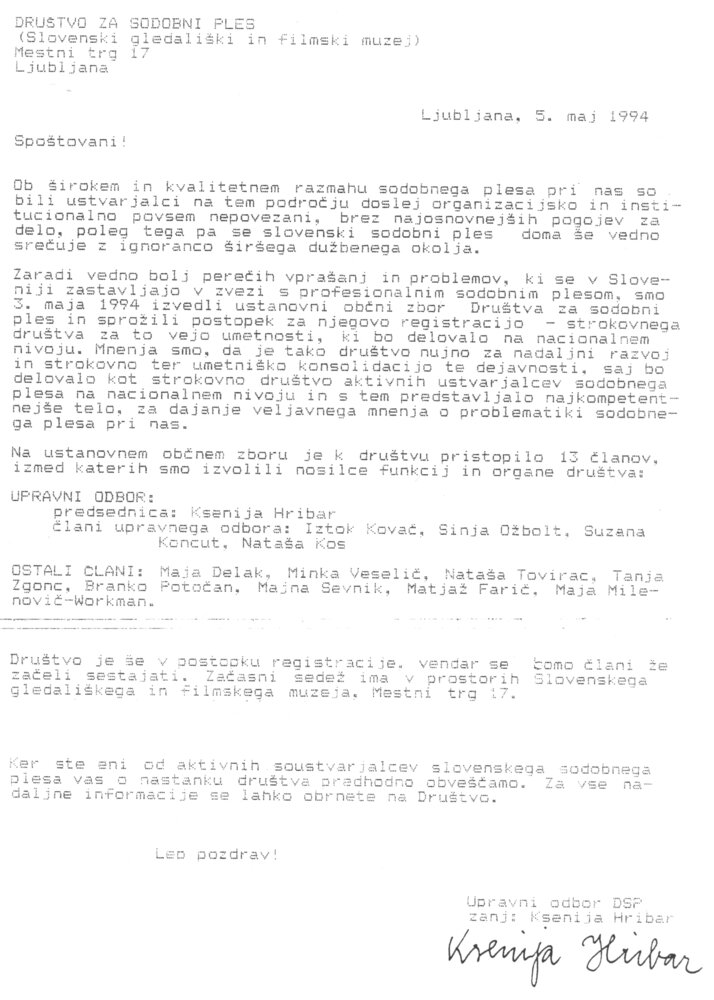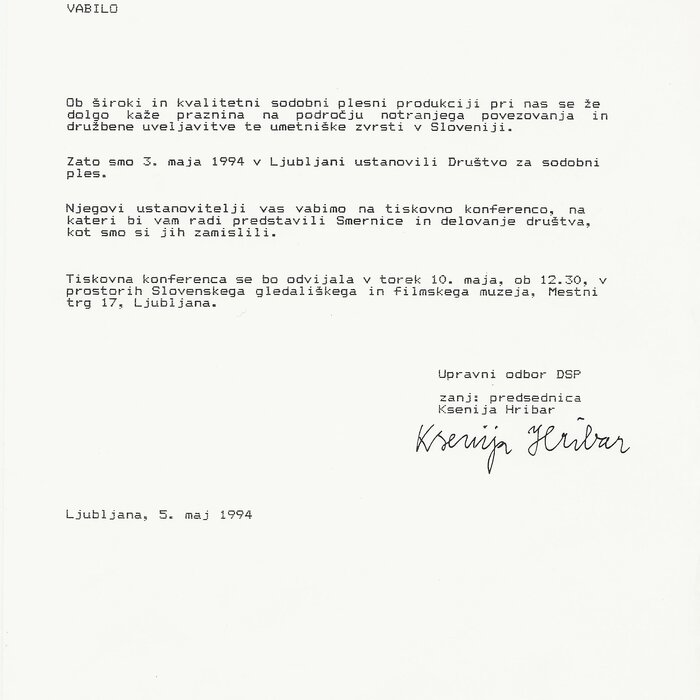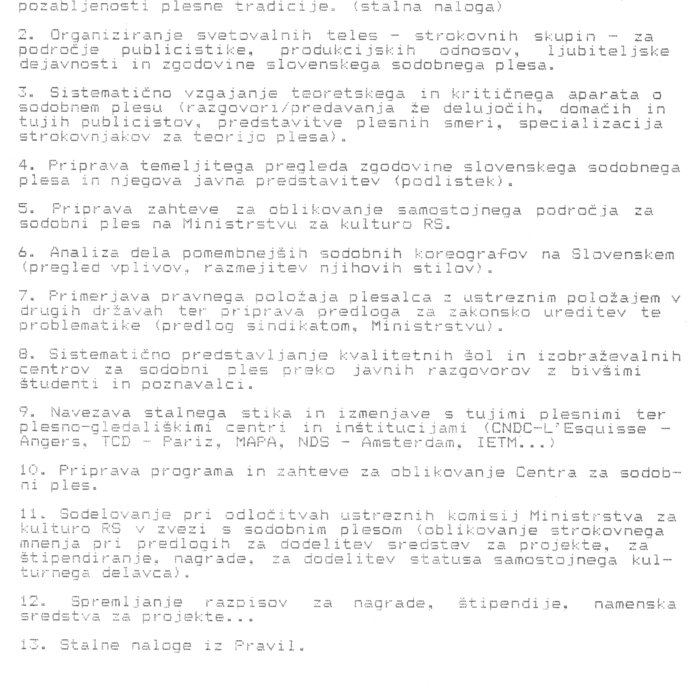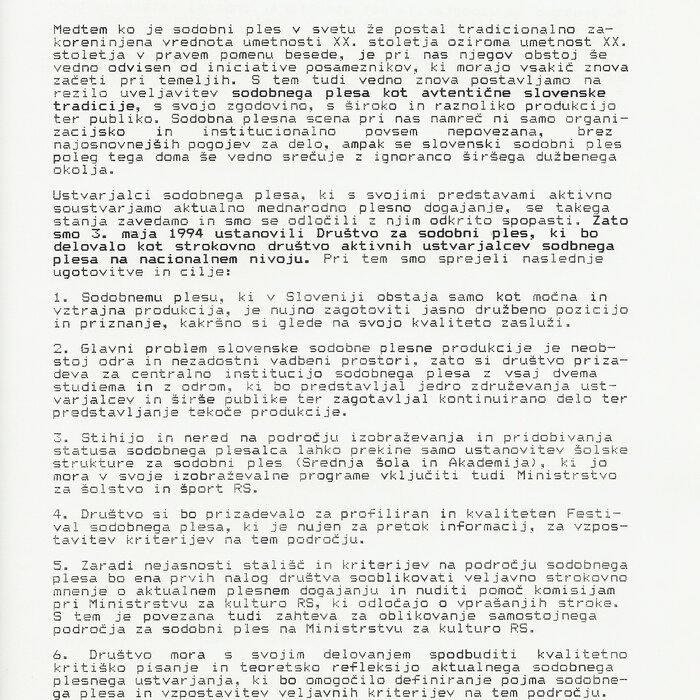On the 3rd of May 1994 Ksenija Hribar, Iztok Kovač, Maja Delak, Suzana Koncut, Eda Čufer founded The Contemporary Dance Association Slovenia, organized the press conference to announce the founding and presented documents of the vision and mission and working plans for the next years.
"The Contemporary Dance Association Slovenia – CDAS (Društvo za sodobni ples – DSPS) was founded on the 3rd of May 1994 in Ljubljana by a group of contemporary dance artists and cultural workers: Iztok Kovač, Ksenija Hribar, Maja Delak, Suzana Koncut, and Eda Čufer. Between 1994 and 1999, its president was Ksenija Hribar (1938–1999). According to the available documentation, a professional association that would bring together artists and cultural workers in the field of contemporary dance had been contemplated at least since October 1985 when the idea was initiated by the circle of dancers and dance teachers around Neja Kos, who had been working at the then Association of Cultural Organizations Slovenia (ZKOS) as a contemporary dance expert since 1977. In the second half of 1985, the newly established Dance Theatre Ljubljana was in full creative swing, and its protagonist Ksenija Hribar was present at all initial meetings. However, it took another nine years for CDAS to be established by the Dance Theatre Ljubljana circle and its allies. CDAS was one of the first professional associations established in the new state of Slovenia and was born of the need for the relatively invisible artistic practice to be provided with the conditions of social representation and systematic regulation. In the document CDAS General Guidelines, its members weigh up the state of affairs in the field, observing the following: (1) a deficit in the social representation of contemporary dance; (2) a lack of space (a lack of performance venues and particularly rehearsal space); (3) a lack of planning in the field of education and a need for a vertical structure in education; (4) a need for an international contemporary dance festival (familiarity with foreign production); (5) a qualitative deficit in the field of professional contemporary dance; (6) a need for a higher qualitative degree of critical, theoretical, and historical publications; and (7) a lack of documenting and archiving contemporary dance in Slovenia. The CDAS 1994 programme included plans for the following: (1) a greater presence of contemporary dance in the media; (2) establishing a professional level that would regulate production and publication (theory and history) in the decision-making system (various professional bodies); (3) ensuring human resources in the field of theory and criticism; (4) historicizing Slovenian contemporary dance and its public accessibility; (5) establishing contemporary dance as an independent area with the Ministry of Culture; (6) analysing the work of major Slovenian choreographers; (7) resolving the legal status of dancers (a solution comparable to systems in other countries); (8) presenting educational programmes abroad, international networking; (9) a public cultural institution dedicated to contemporary dance; (10) involvement in decision-making on the allocation of funds at the Ministry of Culture in the field of contemporary dance; and (11) better knowledge regarding funds for financing this artistic practice. After the death of Ksenija Hribar in 1999, CDAS lost its initial swing. In the first decade of the 2000s, the conditions for contemporary dance slightly improved with some systemic developments in the Republic of Slovenia, before they crashed because of various financial cuts in the period after 2008 and its inability to follow the increasingly bigger dance scene. In 2009, CDAS became the producer of the Gibanica – Biennial of Slovenian Contemporary Dance Art and initiated the Contemporary Dance Network Slovenia, the dance touring plan throughout the state which ceased to function around 2013. It was not until 2023 that CDAS would be financially supported, for the first time, by the subsidies of the Republic of Slovenia."
From Nika Arhar, Jasmina Založnik (ed.), Bodies ofm Dance, Aspects of Dance as Cultural, Political, and Art Work in Yugoslavia and After (Belgrade, 2024)







